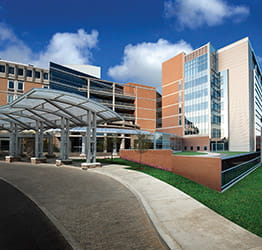What Is CEM?
Contrast-enhanced mammography (CEM) is an emerging breast imaging technology that uses intravenous contrast, similar to that used in CT scanning, to highlight cancers and abnormal breast tissue that cannot be visualized on standard mammograms. CEM has similar cancer detection rates as MRI but is done using standard mammography positioning and technology.
Why Would I Need CEM?
CEM is an alternative to breast MRI and it can be used as a diagnostic tool to evaluate an existing breast cancer, treatment response, and other breast problems.
CEM is being used as part of research studies to screen higher-risk women and may reduce biopsies for women with breast concerns that turn out to be benign.
What are the benefits of CEM?
CEM has several benefits, including:
Improved cancer detection
CEM provides a clearer view of breast tissue than standard mammography, especially for people with dense breasts. CEM is comparable to breast MRI in detecting cancers, including small tumors, and can be used when breast MRI is unavailable, or for people who cannot have a breast MRI. CEM has the potential to enhance early and accurate detection, increasing the likelihood of positive outcomes and successful treatment with less aggressive therapies.
A cost-effective and accessible alternative to breast MRI
CEM requires a shorter exam time (about 10 minutes) and is less expensive when compared to breast MRI. It can be performed with standard mammography equipment, making it more available to patients.
Improved patient experience
CEM is faster and more comfortable than breast MRI, with no need for you to lie face down or enter an enclosed scanner during the exam. CEM can be scheduled more easily with fewer restrictions and can accommodate you if you have a pacemaker, claustrophobia, or other health concerns.
Useful for problem-solving and treatment planning
CEM is ideal for evaluating the extent of breast cancer. It helps measure the stage of your cancer before surgery and monitor the effects of pre-surgical chemotherapy treatment. Standard mammography may underestimate the size or extent of cancer, especially in dense breasts or with specific tumor types. CEM offers better pre-treatment imaging that can help guide surgical and other treatment recommendations.
Potential to reduce the risk of unnecessary follow-ups
CEM has the potential to reduce the need for additional screenings for non-cancerous findings and unnecessary biopsies for conditions that turn out to be benign. As a result, CEM may reduce the anxiety and expense of additional testing for false alarms.
What Are the Risks and Complications of CEM?
Like all medical procedures, CEM comes with some minor risks, including:
- Allergic reaction to contrast dye (uncommon) — About 1 percent of women (1 in 100) will have a mild reaction to contrast dye, which usually causes a hive or two or a mild rash. Your doctor may recommend taking diphenhydramine (Benadryl) if a reaction occurs. There is a very small risk of a severe contrast reaction (less than 1 in 170,000), such as trouble breathing or difficulty swallowing, that would require medical treatment. Our staff are trained in how to manage contrast reactions.
- Radiation exposure — Mammography is a safe, effective, screening and diagnostic tool for most women. However, because mammography uses x-ray imaging technology, it involves exposure to a very small amount of radiation. This dose is highly regulated and considered to be safe. The dose from CEM is approximately 30 percent higher than that of a standard mammogram, but still within accepted limits.
What Should I Expect From CEM?
Before: How to prepare for CEM
There is nothing you need to do to prepare for a breast CEM. However, you should let your doctor know if:
- You have had a prior allergic reaction to IV contrast.
- You have asthma or multiple allergies.
- You have kidney disease.
- You may be pregnant.
How long does CEM take?
CEM takes about 10 minutes. However, you should plan to be at the imaging center for up to two hours.
During your CEM
After you arrive at the imaging center, your nurse will insert an IV into your arm for administering intravenous contrast during the CEM exam. If you are over 60 or have certain risk factors for kidney disease, we might draw a small amount of blood from the IV start to check your kidney function.
During your breast CEM, our staff will:
- Inject contrast dye into your IV. The contrast may cause a warm sensation and make you feel like you need to urinate. This is normal and will go away in a few minutes. You may briefly notice a metallic taste in your mouth. It takes about two minutes for the dye to travel through your bloodstream and highlight suspicious areas in your breast.
- Use the same type of breast positioning and compression as a regular mammogram.
- Take two sets of images: Low-energy images, just like a regular mammogram, and high-energy images to capture the contrast-enhanced areas.
The computer combines images to highlight areas where the contrast has been collected, showing abnormal tissue more clearly. The imaging process usually takes about 10 minutes. A breast imaging radiologist will carefully review the final images.
Recovery after CEM
After the images are taken, your IV will be removed, and you're free to go about your day.
There are usually no side effects from CEM; however, it is recommended to drink water to help flush the contrast out of your body. Although it is uncommon, a delayed allergic reaction (typically characterized by hives or a rash) can occur from contrast, up to one week after the examination. If you develop hives or a rash, you should contact the breast imaging center and your doctor to let them know so this information can be entered into your medical record.
When to call your doctor about complications
You should contact your doctor if you have any signs of infection or other complications, including:
- Severe pain, swelling, or redness at the injection site.
- Skin irritation, hives, or other symptoms of an allergic reaction. If the symptoms are severe, dial 911.
When can I expect my CEM results?
Diagnostic CEM results are usually given to patients on the same day as their appointment.
Screening CEM results (in the research setting) are typically available within 2-3 business days after your exam, and you will receive those from the research coordinators.
As soon as your radiologist finalizes your report, your results will be available to you in your patient portal.
Why Choose UPMC for CEM?
When you choose UPMC for CEM, you will receive:
- Access to advanced imaging technology — Our experts use the latest imaging technology to quickly and accurately diagnose and treat a full range of health conditions.
- Convenient imaging services — Imaging appointments are available at multiple locations with hours that fit your schedule.
- Multidisciplinary care — We partner with surgeons, medical oncologists, radiation oncologists, radiologists, reconstructive surgeons, and other medical experts to treat cancer and other disorders.
By UPMC Editorial Staff. Last reviewed on 2025-08-28.
















